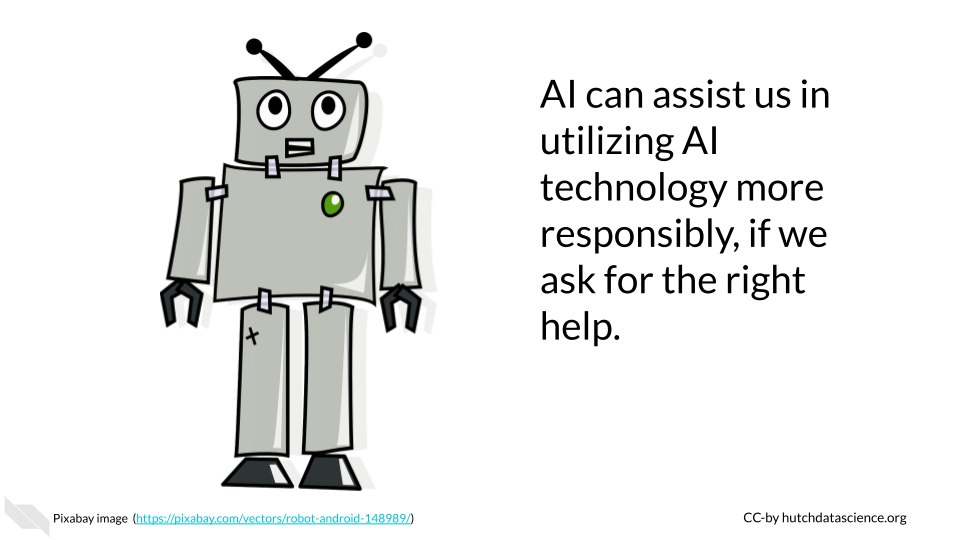
Algorithm considerations
In this chapter we will discuss the some of the major ethical considerations regarding the algorithms underlying AI tools. We will provide some tips for how to deal with these issues that may be useful for creating AI guidelines at your institution.
Disclaimer: The thoughts and ideas presented in this course are not to be substituted for legal or ethical advice and are only meant to give you a starting point for gathering information about AI policy and regulations to consider.
- Toxic Responses - Currently it is not clear how well generative AI models restrict harmful responses in terms of ideas, code, text, etc.
- Lack of Interpretability - When complicated algorithms are used within AI systems, it can be unclear how it came up with a decision. In many circumstances it is necessary to understand how the AI system works to know how to proceed.
- Misinformation and Faulty Responses - Fake or manipulated data used to help design algorithms could be believed to be correct and this could be further propagated. Text, code, etc. provided to users may not be correct or optimal for a given situation, and may have at times severe downstream consequences.
Note that this is an incomplete list; additional ethical concerns will become apparent as we continue to use these new technologies. We highly suggest that users of these tools careful to learn more about the specific tools they are interested in and to be transparent about the use of these tools, so that as new ethical issues emerge, we will be better prepared to understand the implications.
Harmful or Toxic Responses
One major concern is the use of AI to generate malicious content. Secondly the AI itself may accidentally create harmful responses or suggestions. For instance, AI could start suggesting the creation of code that spreads malware or hacks into computer systems. Another issue is what is called “toxicity”, which refers to disrespectful, rude, or hateful responses (Nikulski (2021)). These responses can have very negative consequences for users. Ultimately these issues could cause severe damage to individuals and organizations, including data breaches and financial losses. AI systems need to be designed with safeguards to avoid harmful responses, to test for such responses, and to ensure that the system is not infiltrated by additional possibly harmful parties.

Tips for avoiding the creation of harmful content
For decision makers about AI use:
- Be careful about what commercial tools you employ, they should be transparent about what they do to avoid harm.
- Be careful about the context in which you might have people use AI - will they know how to use it responsibly?
- Be careful about what content you share publicly, as it could be used for malicious purposes.
- Consider how the content might be used by others unintended purposes.
- Ask the AI tools to help you, but do not rely on them alone.
Possible Generative AI Prompt: What are the possible downstream uses of this content?
Possible Generative AI Prompt: What are some possible negative consequences of using this content?
For decision makers about AI development:
- If designing a system, ensure that best practices are employed to avoid harmful responses. This should be done during the design process and should the system should also be regularly evaluated. Some development systems such as Amazon Bedrock have tools for evaluating toxicity to test for harmful responses. Although such systems can be helpful to automatically test, evaluation should also be done directly by humans.
- Consider how the content from AI tools that you design might be used by others for unintended purposes.
- Monitor your tools for unusual and harmful responses.
Lack of Interpretability
There is risk in using AI tools, that we may encounter situations where it is unclear why the AI system came to a particular result. AI systems that use more complicated algorithms can make it difficult to trace back the decision process of the algorithm.
Using content created or modified by AI, could make it difficult for others to understand if the content is adequate or appropriate, or to identify and fix any issues that may arise.
This could result in negative consequences, such as for example reliance on a system that distinguishes consumers or patients based on an arbitrary factor that is actually not consequential. Decisions based on AI responses therefore need to be made extra carefully and with clarity about why the AI system may be indicating various trends or predictions.
Tips for avoiding a lack of interpretability
For decision makers about AI use:
- Content should be reviewed by those experienced in the given field.
- Ask AI tools to help you understand how it got to the response that it did, but get expert assistance where needed.
- Always consider how an AI system derived a decision if the decision is being used for something that impacts humans
Possible Generative AI Prompt: Can you explain how you generated this response?
For decision makers about AI developers:
- New AI tools should be designed with interpretability in mind, simpler models may make it easier to interpret results.
- Responses from new tools should be reviewed by those experienced in the given field.
- Provide transparency to users about how new AI tools generally create responses.
Misinformation and Faulty Responses
AI tools use data that may contain false or incorrect information and may therefore respond with content that is also false or incorrect.
This is due to number of reasons:
- AI tools may “hallucinate” fake response based on artifacts of the algorithm
- AI tools may be trained on data that is out-of-date
- AI tools may be trained on data that has fake or incorrect information
- AI tools are not necessarily trained for every intended use and may therefore may not reflect best practices for a given task or field
AI tools may also report that fake data is real, when it is in fact not real. For example, currently at the time of the writing of this course, older versions of ChatGPT will report citations with links that are not always correct and it doesn’t seem to be able to correct itself very well when challenged. Furthermore, AI models can “hallucinate” incorrect responses based on artifacts of the algorithm underneath the tool. These responses are essentially made up by the tool. It is difficult to know when a tool is hallucinating especially if it is a tool that you did not create, therefore it is important to review and check responses from AI tools. There is also a risk that content written with AI tools, may be incorrect or inappropriate for the given context of intended use, or they may not reflect best practices for a given context or field. The tools are limited to the data they were trained on, which may not reflect your intended use.
It is also important to remember that content generated by AI tools is not necessarily better than content written by humans. Additionally review and auditing of AI-generated content by humans is needed to ensure that they are working properly and giving expected results.

Tips for reducing misinformation & faulty responses
For decision makers about AI use:
- Be aware that some AI tools currently make up false information based on artifacts of the algorithm called hallucinations or based on false information in the training data.
- Do not assume that the content generated by AI is real or correct.
- Realize that AI is only as good or up-to-date as what it was trained on, the content may be generated using out-of-date data. Look up responses to ensure it is up-to-date.
- In many cases utilizing multiple AI tools can help you to cross-check the responses (however be careful about the privacy of each tool if you use any private or propriety data in your prompts!).
- Ask the AI tools for extra information about if there are any potential limitations or weaknesses in the responses, but keep in mind that the tool may not be aware of issues and therefore human review is required. The information provided by the tool can however be a helpful starting point.
Possible Generative AI Prompt: Are there any limitations associated with this response?
Possible Generative AI Prompt: What assumptions were made in creating this content?
For decision makers about AI development:
- Monitor newly developed tools for accuracy
- Be transparent with users about the limitations of the tool
- Consider training generative AI tools to have responses that are transparent about limitations of the tool.
Example 3 Real World Example
Stack Overflow, a popular community-based website where programmers help one another, has (at the time of writing this) temporarily banned users from answering questions with AI-generated code. This is because users were posting incorrect answers to questions. It is important to follow policies like this (as you may face removal from the community). This policy goes to show that you really need to check the code that you get from AI models. While they are currently helpful tools, they do not know everything.

Summary
Here is a summary of all the tips we suggested:
- Design new AI systems with interpretability in mind
- Don’t assume AI-generated content is real, accurate, consistent, current, or better than that of a human.
- Ask the AI tools to help you understand:
- Sources for the content that you can cite
- Any decision processes in how the content was created
- Potential limitations
- Potential security or privacy issues
- Potential downstream consequences of the use of the content
- Always have expert humans review/auditing and value your own contributions and thoughts.
Overall, we hope that these guidelines and tips will help us all use AI tools more responsibly. We recognize however, that as this is emerging technology and more ethical issues will emerge as we continue to use these tools in new ways. AI tools can even help us to use them more responsibly when we ask the right additional questions, but remember that human review is always necessary. Staying up-to-date on the current ethical considerations will also help us all continue to use AI responsibly.